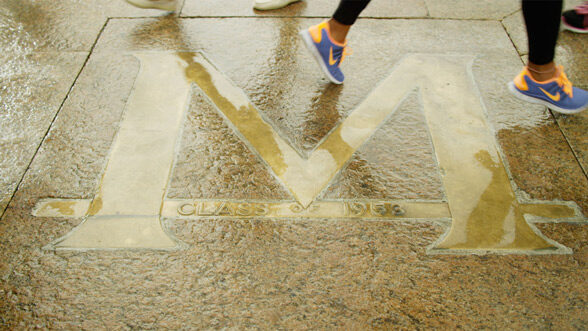Good moral character: Two centuries of admitting the “leaders and best”
 In bedrooms, libraries, and coffee shops all across the country, anxious high school seniors are drafting and redrafting personal statements, gathering official transcripts, and deciding which of their favorite teachers to bug for those ever-important letters of recommendation.
In bedrooms, libraries, and coffee shops all across the country, anxious high school seniors are drafting and redrafting personal statements, gathering official transcripts, and deciding which of their favorite teachers to bug for those ever-important letters of recommendation.
College application season is here. It’s a stressful time. But it wasn’t always like this.
In fact, the hoops through which students have leapt to attend the University of Michigan in decades and centuries past – the surprisingly specialized entrance exams, the mandatory medical exams – seem almost unrecognizable in today’s world of SAT prep courses and universally accepted online applications.
Here are just four examples of how the methods for admitting the “leaders and best” have evolved throughout the University’s 200-year history.
Earliest applicants had to prove their skills in Latin, Greek
Although different in subject matter and format from the standardized tests that serve as nightmare fodder for high school juniors and seniors today, the first university students also had to show their proficiency in a number of exams. The six freshmen and one sophomore who began classes on Sept. 25, 1841, completed an examination in mathematics, geography, Latin, and Greek.200 years of student enrollment
From admissions to financial aid to freshman orientation, the student enrollment experience at the University of Michigan has evolved dramatically over the past two centuries. Here are a few of the more interesting – and sometimes, odd – examples from U-M history:
1841 – The University’s first students — six freshmen and one sophomore, all men — begin classes after completing entrance exams in math, geography, Latin, and Greek and furnishing “satisfactory testimonials of good moral character.” Each student pays a $10 entrance fee.
1871 – While students could still gain admission through entrance exams, the University begins admitting students from Michigan high schools that had earned its accreditation. Graduates of the high schools in Detroit, Ann Arbor, Flint, Jackson, Kalamazoo, and Adrian earn automatic admission.
1897 – First student loans granted by the University. The funds come from alumni groups and others interested in assisting needy students. Starting in 1921, students are required to appear before U-M’s Committee on Student Loans and complete an application with the amount of money desired, personal history, and estimated yearly budget.
1919 – A complete medical examination of all new students becomes an established requirement. For women, the process is especially comprehensive, including a form with 18 questions on menstrual function, preferences for bath water temperature, and a history of medical problems like joint pains, urinary disturbance, and “blood spitting.”
1927 – The University hosts its first Freshman Week as an orientation period for new students. They receive lectures on library use and studying, take placement tests, and attend lawn parties hosted by Dean of Students Joseph Bursley and his wife. Men and women also participate in same-sex athletic competitions.
1935 – During the Great Depression, the number of student loans increases from 885 in 1929 to 2,600. The Board of Regents creates more than 65 new scholarships during this time, and a textbook lending library is established in 1937.
1947 – The G.I. Bill leads to mounting enrollment and the first appointment of a director of admissions. By fall 1947, 11,000 of the 20,000 resident students are military veterans. The Veterans Service Bureau is established, as well.
1981 – The Computerized Registration and Individual Selection Program, or CRISP, reduces the time it takes to register for classes.
2003 – The U.S. Supreme Court affirms the University’s ability to consider race as one of many factors in its individualized, holistic admissions decisions, ending a six-year court battle.
2006 – The passage of Proposal 2 by Michigan voters amends the state constitution to effectively ban discrimination and preferential treatment on the basis of race, ethnicity, gender, and national origin in public education, employment, and contracting by public institutions.
2014 – The Office of Enrollment Management is established — bringing together the offices of Undergraduate Admissions, Financial Aid, New Student Programs, and the Registrar.Satisfactory results, along with a $10 entrance fee and the requirement to “furnish satisfactory testimonials of good moral character,” granted a student admission in the University’s earliest days.
But satisfactory results weren’t a given for students hoping to enter U-M in those early decades. Exam questions were difficult and often broad in scope.
“The College Student’s Manual,” a no-frills handbook for prospective college students published in 1884, offered the following examples of questions that students should expect to encounter, in addition to translating large sections of Latin and Greek texts:
- Prove that the square of a side of a triangle opposite an acute angle is equal to the sum of the squares of the other two sides diminished by twice the product of one of these sides and the projection of the other upon that side.
- Enumerate in regular order, beginning to the north of the Straits of Gibraltar, all the countries of Europe, Asia, and Africa, bordering on the Mediterranean Sea.
- Write a composition upon any one of the subjects given below. Let it contain not less than two 250 words, and not more than 300:
- The History of the English Language
- Colonial Days in New England
- Old Dutch Times in New York
- A Walk in London, in Paris, or Washington
Universities described these requirements in annual catalogs, but hopeful students didn’t always take heed.
As the handbook’s author noted: “Many disappointed applicants for admission each year evidently suppose that the examiners do not require as thorough an examination as they publish.”
Before registering for classes, please turn and cough
As academic requirements evolved over the decades, so too did other aspects of the admissions process.
Starting in 1919, for example, a complete medical examination of all new students became an established prerequisite for attending classes at U-M. During an era when contagious diseases like tuberculosis and measles were much more common – and on the heels of the deadly 1918 Influenza Pandemic – the University saw the need to proactively address medical issues among its students.
Every year, during “registration week,” extra personnel were hired and the army-station method used. One doctor’s note was cited in a publication commemorating the 25-year anniversary of the University Health Service: “We are watching the condition of his heart, lungs, digestive organs, of his eyes and skin, if he has flat feet or has lost a finger or a limb, that is (written) down. The examination of the body is a complete one.”
For women, the process was especially comprehensive, including a form with 18 questions on menstrual function, preferences for bath water temperature, and a history of medical problems like joint pains, urinary disturbance and “blood spitting.”
In addition to the check-up, all freshmen were required to attend six health lectures during their first year. Topics included general hygiene, personal health, and “sex hygiene.”
University Health Service officials said the exams most likely ended by the late 1930s.
World War II and the birth of modern admissions at U-M
The undergraduate admissions framework we see today has its roots in the post-WWII pressure of mounting enrollment that jolted the campus in the late 1940s. By the fall of 1947, resident enrollment reached 20,000 students, of whom 11,000 were military veterans supported by the G.I. Bill of Rights.
The first director of admissions was appointed in the same year to determine which applicants were qualified and to admit no more than each school and college could accommodate.
Skyrocketing college interest presented an unprecedented challenge to U-M and universities across the country, says Michael Bastedo, professor and director of U-M’s Center for the Study of Higher and Postsecondary Education.
“There was a time when you could just walk into the president’s office and ask to take a test,” Bastedo says. “There had always been a strong need to add enrollment. Suddenly, at the most elite schools they’re having to be more and more selective. Now, they have too many applications to handle.”
In addition to an influx of veterans, this era also saw growth in high school graduation rates and interest overall in college education, Bastedo says.
Previous processes that funneled students from U-M-accredited high schools into the University became less and less feasible, and the reliance on standardized testing took a stronger hold.
In 1951, college applicants took 80,000 SATs nationwide. A decade later, that number had increased tenfold.
“Now the question is, ‘who among the students are we going to pick?’” Bastedo says.
Michigan Mandate brings student recruitment to the forefront
When James Duderstadt was elected as the University’s president in 1988, the foundation was already in place for what would later be hailed as “one of the most comprehensive diversity initiatives ever undertaken by a predominantly white research university.”
Following the civil rights movement of the 1950s and 60s, the campus had faced growing frustration from students and faculty concerned with minority underrepresentation and racial incidents at U-M.
Then-provost Duderstadt brought together diverse groups on campus to craft the landmark Michigan Mandate, promising to increase the numbers of underrepresented students and faculty and change the culture at the University to be more inclusive.
 Admissions would have a crucial role, and the department’s methods had to change.
Admissions would have a crucial role, and the department’s methods had to change.Prior to the early 1990s, staff in the Office of Undergraduate Admissions did very little recruiting and made no strategic effort to recruit minorities, says Ted Spencer, former longtime director of the office.
That changed when Spencer took the department’s helm in 1991. A retired lieutenant colonel in the United States Air Force, Spencer had previously worked to bring more women and minorities to the Air Force Academy.
“We had to develop three things: find the kids, find out what makes kids successful, and gather counselor input,” Spencer says.
Not everyone was on board, he notes, explaining that prior to this time, admissions officials worked primarily as counselors responding to students who reached out to them.
“Are we counseling people or are we trying to recruit them to come to our college?” Spencer says he remembers staffers asking him. “A lot of people thought of recruiting as a used-car salesman approach. Some left, and some retired.”
But the efforts – which included the creation of a Detroit-based admissions office and tapping into new out-of-state student pools – proved successful in meeting the Mandate’s goals. By the late 1990s, the minority student population had doubled.
Lawsuits challenging the admissions practices at the time reached the U.S. Supreme Court, where in 2003, justices upheld the ability to consider race as one of many factors in university admissions to achieve the educational benefits of a diverse student body.
Michigan voters negated the 2003 ruling when they approved a proposition in 2006 that prohibited discrimination and preferential treatment on the basis of race, ethnicity, gender, and national origin in public education, employment, and contracting. “Prop 2” eventually was upheld by the Supreme Court.
The mission continues
 Today, the admissions office’s mission is to “recruit, admit, and encourage enrollment of applicants who are academically excellent, accomplished in extracurricular endeavors, and broadly diverse.” A diverse mix of students fosters the “vibrant educational atmosphere that provides the best educational experience for all students,” the mission statement reads.
Today, the admissions office’s mission is to “recruit, admit, and encourage enrollment of applicants who are academically excellent, accomplished in extracurricular endeavors, and broadly diverse.” A diverse mix of students fosters the “vibrant educational atmosphere that provides the best educational experience for all students,” the mission statement reads.The office facilitates a wide range of programs specifically geared, within the restrictions of the law, toward recruiting and enrolling underrepresented students, including application workshops, campus visits, and after-school college readiness programs in key Detroit and Chicago high schools. The office also has fostered robust partnerships with many community colleges to strengthen pipelines for student transfers.
Each admissions counselor specializes in a specific region to understand the high schools of the students they serve. This allows counselors to review applications holistically with an understanding of each student’s unique circumstances and better assist applicants throughout the process.
“Our goal is to select students who shape and create a campus community that will adapt to the challenges facing our University, the United States, and the world,” Office of Undergraduate Admissions Director Erica Sanders says. “Considering each student’s achievements holistically will continue to help the University accomplish its goals.”



Mike Jefferson - 1979
Now the only requirement is to be an anti-American, far left, snowflake.
Reply
William Hoover - 1961 PhD and MSChem
It is a pity that excellence is not the sole requirement for admission and graduation. It is a fable that divisiveness through “diversity” is a better goal than a colorblind society.
Reply
Angela Spencer - 2012
I agree.
Reply
Linda Head - 1955 BM(education); 1958 (Jan.) MMus
In the fall of 1951 I was an incoming Freshman, and vividly remember going to the Waterman Gym with the other women in my group, stripping and putting on a white sheet and going from station to station where we answered questions about all aspects of our health. I mentioned that I had experienced pains in my knees during sports, and I was happy to sit on the chair by the “sports” doctor’s desk and let him grab and gently twist my leg. He said “Where did you get the trick knees?” and wrote me an exemption from active sports, much to my relief. So it wasn’t entirely a negative experience, from my point of view.
1951 may have been the last year women went through that “army recruitment” type of treatment.
Reply
Mark Bush - 1980
Timeline is misleading re 2003 Supreme Court decisions. While the University did prevail in the law school case, it lost the companion LSA case in which its admissions process, and use of race as a factor, was struck down as unconstitutional. I teach these casrs in my civil rights course.
Reply
william hoover - 1961
Thanks very much for the clarification Mark. I had the impression that race had been ruled out as a component of admission by the Supreme Court and that it is obvious that race-based policies are unconstitutional, but didn’t have the facts handy. For years I have supported Ward Connerly’s efforts through the American Civil Rights Institute to eliminate race-based affirmative action. I’m glad you are helping to educate the whippersnappers.
Reply